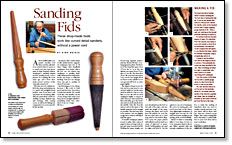Sanding Fids
These shop-made tools work like curved detail sanders, without a power cord
Synopsis: A fid is a traditional tapered wooden tool that’s used by sailmakers to stretch holes in canvas or rope grommets. King Heiple explains how to use this tool to sand wood, and he shows how easy fids are to make. They’re useful for sanding carvings, furniture legs, and turnings with varying coves, and for fairing one compound cove curve smoothly into another. And they help your sandpaper last longer. The degree of taper isn’t critical, but the taper must be uniform.
A fid is traditionally a tapered wooden tool that’s used by sail makers to stretch holes in canvas or to stretch and size rope grommets. In Italy, furniture makers developed a similarly shaped tool for sanding wood. I saw a picture of a sanding fid a few years ago, and I have since made several versions of this curiously named tool.
Fids turn out to be widely useful in the shop, and making one is a quick and straightforward project, even if you have only very basic wood-turning skills. Fids are particularly useful for sanding carvings, furniture legs and turnings with varying coves, as well as for fairing one compound cove curve smoothly into another.
As anyone who’s used a drum or disc sander knows, supported sandpaper lasts two to 10 times longer than handheld sandpaper. Even better, with a fid you can use almost any sandpaper or sanding cloth, without the need for snap locks, hooks and loops or adhesive backing. And you can change from one grit to another in about 10 seconds.
My fids happen to be cherry, because I like tools to look good and feel nice, but even a construction-grade 2×2 would work fine. The handles can be of any design that meets your fancy, from a straight cylinder to something better than mine. Each of my two longer fids has a 61⁄2-in.-long tapered portion, and my shorter fid has a 3-in.- long tapered portion. The thicker of the long fids tapers from 113⁄16 in. dia. to 7⁄16 in. dia.; the thinner one tapers from 11⁄16 in. dia. to 3⁄8 in. dia. The short fid is 21⁄4 in. dia. at its base and tapers 1⁄4 in. over its 3-in. length, about as close to a true cylinder as you can get and still lock on sandpaper tightly.
The degree of taper is not critical, and you may need to turn several variations, but the taper must be uniform—that is to say, flat—or your fid will not hold sandpaper tightly or support it well. Once you have turned the fid on the lathe, go to the bandsaw and cut a kerf exactly down the middle of the fid, from the narrow end of the taper to the handle. Keep the kerf as straight as possible. The kerf may have to be sanded a bit, but slightly rough inner surfaces will help it hold the paper.
From Fine Woodworking #136
For the full article, download the PDF below:

















Log in or create an account to post a comment.
Sign up Log in